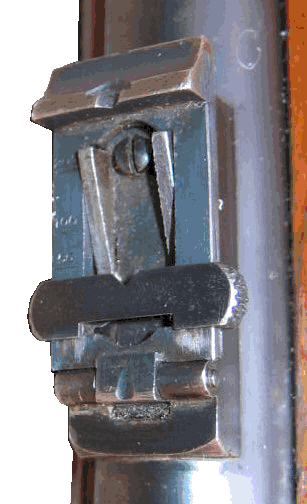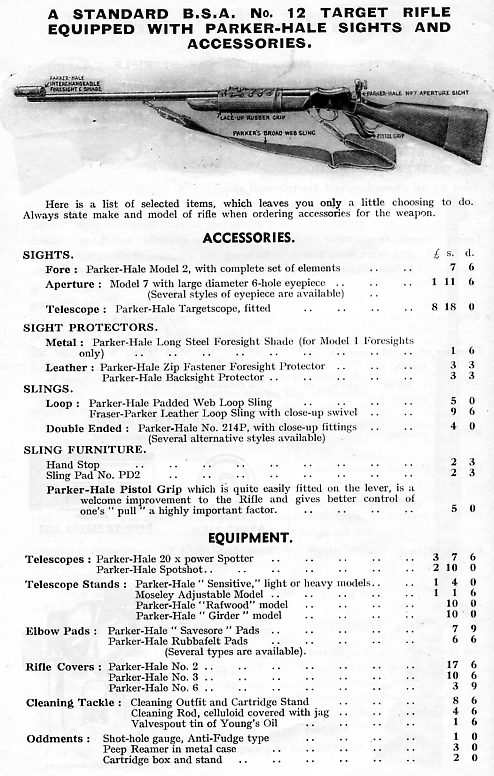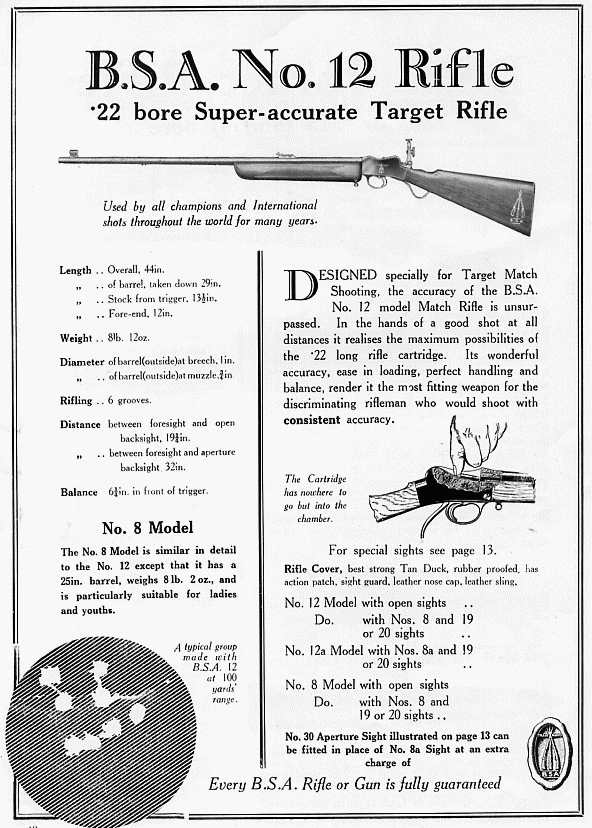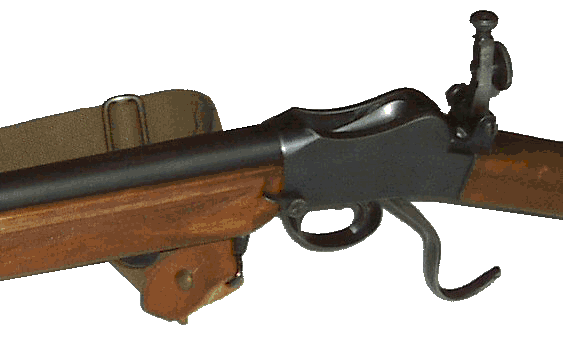
See also: BSA Model 12 adapted for rapid-fire competition

~ We have not been able to ascertain
the exact date on which the Model No.12 rifle was first introduced to the pre-Great
War shooting scene and, although it is  shown
in an early B.S.A. catalogue listed as "the latest thing in specialised
TARGET RIFLES ", unfortunately the catalogue in which it appears is
undated. However, the catalogue does carry a report of a world record achieved
with a Model 12 rifle. We are told that "Mr. Oldman of Norfolk won the
Eastern open championship in September 1912 with a score of 587 deliberate and
rapid out of a possible 600".
shown
in an early B.S.A. catalogue listed as "the latest thing in specialised
TARGET RIFLES ", unfortunately the catalogue in which it appears is
undated. However, the catalogue does carry a report of a world record achieved
with a Model 12 rifle. We are told that "Mr. Oldman of Norfolk won the
Eastern open championship in September 1912 with a score of 587 deliberate and
rapid out of a possible 600".
This is the earliest report of a major competition result yet found for the Model 12.
 The
page reproduced
The
page reproduced
along-side carries
the specifications of the
Model 12 rifle on offer
in the early 1920s.
Little changed from the time
of its introduction.
The basic price has
increased from £3:10s:0d
(£3.50) to a comfortable
round Five Pounds.
No such thing as
£4.99 in those days!
( But such prices as £4:19s:6d were occasionally in evidence )
added £1:4s:6d ( £1.22½p )
to the basic price.

~ There is no mention of the Model 12 in Ernest H. Robinson's book on .22" shooting called "Rifle and Carton" (first edition 1911), but it appears in the third edition of 1914. Diagrams shown in the book are made with B.S.A. Model no's. 8, 10, 10a etc., as well as the Greener, and there is a mention of the "Olympic model" made by Greener for the Miniature Ammunition Manufacturing Co., of Pall Mall. The "Olympic" being possibly the first of the heavy barrelled TARGET RIFLES . The head of the M.A.M.Co. was apparently "a well-known shot", (so well known that the book does not give his name). Who was he?
 All the
researched information would suggest the Model 12's introduction date to be
at some point during 1911 or early 1912, and it is presumably coincidence that
the model number and date seem the same. As B.S.A. miniature calibre rifles
appear to run from model number 1 through to 13, then jump to 15, there is no
certainty of any date/model number relation. In the third edition of Lt. Robinson's
book of 1914, he states that the best rifle is undoubtedly the No.12 model,
also saying that, where expense is
All the
researched information would suggest the Model 12's introduction date to be
at some point during 1911 or early 1912, and it is presumably coincidence that
the model number and date seem the same. As B.S.A. miniature calibre rifles
appear to run from model number 1 through to 13, then jump to 15, there is no
certainty of any date/model number relation. In the third edition of Lt. Robinson's
book of 1914, he states that the best rifle is undoubtedly the No.12 model,
also saying that, where expense is
no object, there is no doubt the No. 12 is splendid value. However, in the
1911 first edition, he had used exactly the same wording, making the same claim,
for the "Greener" (understood to mean the Greener
"Miniature Club"). The Greener rifle's barrel detachment was then
achieved by pressing and rotating a thumb lever which slackened the barrel thread,
clamped by virtue of a slot machined in the underside of the action body; after
which the barrel could be unscrewed. A feature of the then "new" B.S.A.
miniature rifles was also the detachable barrel. The same method of detachment
was still attributed to the B.S.A. Model 12 in the 1914 edition of Robinson's
book, but we suspect that this was a "typo", because to date we have
only seen take-down models with a tapered locking screw, never with a thumb
lever. But perhaps there is an example lurking out there somewhere!
~ In another of (by then Captain) Robinson's books, "Rifle and target"- 1930, he states that the Model 12 was the first target rifle with a 'wide target fore-end'. The 12 was built on a slightly heavier action than the previous models, the total width of which was 1 ¼", as opposed to 1" on earlier models. This wider action was carried forward to the Model no's 13, 15, and 12/15.
~ The early model 12 rifles can be identified by a number of differences. Those that we have found so far are:
1) - the chequering on the fore-end covers a larger area and is much finer.
2) - a cocking indicator is fitted at the side of the loading/breech block (this carried on until the early 1930's).
3) - the early pattern of B.S.A. No. 8 folding rear-sight does not have click adjustments. A spring & plunger can also be seen inside the stem of the sight to take out backlash on elevation.
~ In their early days, B.S.A. rifles had a suffix system of lettering, after the model number, to identify the specification of manufacture or accessories fitted; i.e.: 8a, 8b, 10a, etc. So it was that the Model 12, fitted with tangent leaf rear and blade/barleycorn fore-sight, cost 70/- (£3.50). A Model 12a, was fitted with the No. 8 folding rear-sight and the No. 19 target fore-sight at a cost of 83/6 (£4.17 ½). An allowance of 3/- (.15p) was made if the tangent leaf sight was not required.
~ The 1927 edition of "Small-bore Rifle Shooting" by E.C. Crossman (U.S.A.) advises that " the model 12 has been popular despite the high tariffs charged". The price there was $65 as against a new Winchester Model 52 at only $36. From U.K. catalogue prices at the time, it is apparent that the reverse situation applied 'on this side of the pond'! We are unable to understand the reference in this book to the "new longer fore-stock" (fore-end as we now call it). Did this refer to the Model 12 'target fore-end', as opposed to the woodwork on the early Models 6 & 8, which was smaller, or did B.S.A. produce an export model? We think the former is the more likely.
~ We are aware that the American market preferred the fitment of the Lyman 48 rear-sight, which allowed for cleaning of the barrel from the breech end. But it was stated at that time that the B.S.A. No. 8 sight was one of the best on the market.
The excellent folding No.8 sight was an original purchase
option shown left. Also illustrated is the latterly available Parker
"Quickloader" ammunition block, which was held in place by a
lug fitted under the slotted head of the action retaining pin .
This was for use in rapid or timed fire disciplines. The cocking
indicator on the RHS of the breech block is also to be seen - in
the cocked position. With the rifle uncocked, or fired, it drops
flush with the top of the action block.
See page on the .22 MARTINI and the LEE_ENFIELD TRIGGER PULL
~ By 1930 the model 12 is shown in the A.G. Parker catalogue in take-down form. It was fitted with a deep fore-end, the chequering on which covered a large area and was fairly course. We have seen several take-downs with deep fore-ends that have a smaller panel of finer chequering, which we believe was an earlier variation from possibly the 1920's. On these rifles, the cocking indicator lever is still present. The rifle was advertised as a basic No.12 with open sights at £5-12s-0d, and with B.S.A. nos. 8 & 19 sights at £6-4s-6d. The 12b was as the 12a, but fitted with a 6 hole eyepiece at an inclusive price of £6-7s-6d. The 12d, fitted with a Parker-Hale No. 7 back-sight & B.S.A. No.19 foresight cost £6-12s-6d, whilst a 12e was as the 12d, but fitted with the Parker-Hale model 1 interchangeable foresight, all in at £6-15-0. In England, a basic Winchester model 52 at this time cost £9-15-0, a premium equivalent to that at which the B.S.A. sold in America.
 The standard rear-sight was a tangent leaf graduate for 25, 50,
100 and 200 yards >>>
The standard rear-sight was a tangent leaf graduate for 25, 50,
100 and 200 yards >>>
~ The Parker-Hale Dewar rifle of 1930 was built up from the Model 12 action. It was expensively produced with a matted rib to the foresight, Parker-Rifled, filecut topsides to the action, inlaid silver name on the left side plate, a longer fore-end, and pistol-grip butt with a special under-lever. The extra work was reflected in the considerable price for the day of £15-15-0.
~ By 1936, Parker-Hale had introduced the A.G.P. Model 2 tunnel fore-sight (the design evolved into the Model 22). The total price remained the same as in 1930 for the rifle Models 12, 12a, 12b, (but there was no 12d or 12e), just a 12f fitted with Parker-Hale Model 2 fore-sight at the price for the old Model 12d of £6-12s-6d. A 1936 catalogue shows the Models 12, 13, 15 & 12/15, but no Model No. 6 or No. 8. By then these had disappeared from the listings.
At some point between 1929 and 1939, when the headquarters of the Society of Miniature Rifle Clubs was based in Ludgate, London, the Society had made arrangements with the Birmingham Small Arms Company to allow members to purchase a BSA rifle in instalments.
A leaflet was issued that made it possible for a householder wishing to buy any BSA model to pay an initial instalment, after which their chosen rifle would be despatched - subject to the usual terms and approval. Monthly payments were then fixed at a rate shown on the application form illustrated below.
The example given was the Model 12 with a Model 8A rear-sight and a Model 19 fore-sight.
The purchase could be over either six or twelve months, the latter requiring twelve monthly payments of twelve shillings (60 pence in today's decimal currency) for a total of seven pounds and four shillings including the interest, on a rifle that would otherwise cost £6:7s:6d bought directly.
Below: A pair of 1939 advertisements for the Model 12


~ By 1941, the famous B.S.A. Model 12 had taken on its final form. Gone were the cocking indicator, deep fore-end and No's. 8 & 19 sights. The chequering panel was a little smaller, but the chequering its self was not as fine as on the earlier rifles. A sling eye seemed by then to be a standard fitting to the front of the fore-end, in addition to the original one under the barrel. The standard front sight was now the B.S.A. Model No. 20 (the same one was fitted to the Model 15 and Centurion Match rifles). It has only one lug or ear on the bottom of the element, unlike the Parker-Hale Models 2 or 22, which have one lug on each side. Anschutz and most other manufacturers now mirror the latter design. The rear-sight was a B.S.A. No. 30, again a variation of the sight fitted to the Model 15 rifle, with a base similar to that on the Parker-Hale Nos.7 and 7a rear-sights.
Below is a 1938 B.S.A. Gun Works Drawing of the 6 groove, 16" pitch, rifling of the Model No.12 rifle barrel of the day.

~ In 1941, the Model 12 rifle was still offered with open sights at a price of £5-10s-0d. The Model No.12a with B.S.A. No's 20 and 30 sights cost £7-5s-0d, whilst the Model 12f rifle, with Parker-Hale Model 2 fore-sight and No.7 rear-sight was again priced at £7-5s-0d. This is possibly the most common Model 12 rifle configuration now encountered , for most older rifles have been converted to this specification over the years. One tell-tale sign can be the presence of a block fitted to the barrel to take the earlier Model 19 sight, as most of the No's. 2, 20, & 22 sights were dove-tailed into the barrel itself. One particular point of interest is that the Winchester model 52 'bull-gun' had by then increased in price to a startling £38-10-0.
 The
tip-over blade and aperture No.19 fore-sight can be seen here to the left -
in need of dusting!
The
tip-over blade and aperture No.19 fore-sight can be seen here to the left -
in need of dusting!
To switch between blade and aperture, usually a small lever is fitted to the end of the pivot pin -
(hidden on the blind side here ), otherwise a screwdriver is required to make
the change-over pivot rotation.
The aperture in the ring was incredibly small ~ for twenty-year-old eyes in fact! the
various Parker companies ( A.J., A.G. and Parker-Hale ) offered fine reamers specifically for
adjusting the aperture to the individual's requirement. Many of these fore-sights were
subsequently removed; the rifle being fitted with the later design of
Parker-Hale Model 2 tunnel foresight ( or its BSA equivalent - the No.20 ) with interchangeable
steel elements of the type used in Anschutz and BSA TARGET RIFLES well into the 1970s,
before even these were superseded by perspex elements and more recent adjustable aperture foresights.
 An
interesting development of the BSA No.19 foresight
An
interesting development of the BSA No.19 foresight
recently came to light at an historic miniature rifle competition.
A most unusual windage-adjustable barrel-band mounted adaptation is shown, right.
The No.19 sight tunnel's own dovetail is arranged to slide comparatively freely in the adapter's dovetailed groove. The windage can then be adjusted by respectively slackening and tightening the appropriate knurled knobs, whose set-screws bear on the ends of the No.19 dovetail.
Our thanks to the contributor, Tony Cattermole, collector and shooter, on whose Model No.12 rifle this fore-sight resides. He advises us that the band/mount fitting is a casting, not individually or custom made, and he believes it may well have been fitted as an option when the rifle was new. If you have any information as to the origin of the adapter, then do please let us know.
~ By 1947, the "famous 12"
no longer appears in the catalogues. It had gone to join those other great TARGET RIFLES
on that rifle range in the sky where every shot is a bull and every card
a possible. (L.E.K. waxes lyrical. Ed). The exact date on which production
finished is not presently known to us.
The B.S.A. Model No.12 must have achieved one of the longest running production
periods for any target rifle, and has been given a new lease of life in the
various historic & classic competitions that are now growing in popularity.
We have acquired some original test cards from a Model 12 and, considering how
the accuracy of ammunition has improved since then, the groups would put some
well-known more modern small-bore TARGET RIFLES
to shame!

Finally, BSA manufactured "take-down" versions of some of their sporting and TARGET RIFLES . We show below three images of a Model 12 rifle so configured; with thanks to Eric and Phil for providing them. The Model 6 rifle is also shown on its' reference page in an earlier, non-split receiver, take-down form.
W.W. Greener was another manufacturer who offered a number of his own rifles as "take-down" models, using a similar, but not quite identical, system to that used by BSA on this Model 12, in which the action body was split vertically down its centre-line of its' forward section to enable it to be clamped upon the barrel breeching thread. It has been suggested that the basic design of such a system was originally invented by "W.W." himself.
Below: the clamping lever rotating around the action locking pin on a threaded end opposite to the standard locking pin arrangement on the out-of view RHS of the action body.

Below: the barrel and action separated by the "quick release" system in which the lever is rotated to release the clamping action on the barrel breeching thread, when the barrel can be unscrewed from the body. The whole process takes only a few seconds and permits the rifle to be transported in a case little larger than a slightly over-long brief-case.

Above and below: the split in the receiver body can be clearly seen, as can the spring-loaded locating pin on the RHS of the breehing thread, which engages with a slot in the barrel reinforce to ensure that the barrel and foresight are upright in relation to the action and butt-stock.

The slot, like a key-way, which can be seen cut into the top of the breeching thread, is simply to assist in the flexing of the closure of the clamping action. The actual movement of the body, in clamping the barrel thread, is so small that any fatigue in the metal is miniscule. Rifles with these split actions have maintained their integrity over nearly a hundred years of use and many thousands of operations.
It will also be seen that the serial number of this rifle is 19,486.
We receive occasional enquiries regarding BSA rifles and the possibility that their serial numbers indicate the date of manufacture. For those who may be seeking such information, we copy one such enquiry and, in part, our reply below.
Query: I am the proud owner of a Model 12
that I have owned for 30 years. All serial numbers match. They are 24,XXX. Is
there any info on the approximate manufacture date?
Thanks very much, any info will be greatly appreciated.
Answer: Dear
....... ,
................................. in production for more than 30 years, with
most manufactured between the two World Wars, and an as yet undiscovered total
production figure, accurately dating a Model 12 is not something we have not
been able to easily achieve.
John Knibbs, now retired, worked at BSA for many years and holds most of the surviving records for
BSA production. In his excellent book on BSA - "The
Golden Century" ( see Recommended Reading),
he largely only details serial numbering for later models with prefixed serial
numbers. Many BSA records were lost, if we recall correctly, as a result of
bomb damage in Birmingham during the last War.
Our best estimate is that the total production was of the order of 60,000 rifles, although this could be wildly inaccurate as it is partly derived from serial numbers seen on rifles at auction, and there is no guarantee that the series started with No.1, although that was the most usual system at that time. One rifle was reported, in a catalogue, with a serial number of 586555 but, since most seem not to much exceed 58,000 we suspect this may be a misprint with an extra "5"!
Also, most auctioneers are unwilling to state the Model number, with good reason - models are confusing in appearance, often modified or updated, and identification is therefore not at all easy - thus a serial number cannot always be attributed to a Model 12; only the fact that it was doubtlessly the model with the greatest production is an indication that the highest numbers are Model 12 rifles.
All this supposition means that it might not be unreasonable to estimate that, with limited production in the periods over both Wars, most production was between 1919 and 1937/8, a period of approximately 20 years including the two years prior to WWI. An average annual production figure of around 3,000 would therefore seem a reasonable estimate. Divide your own rifle's serial number by 3,000, add the figure to 1912, and you may have the approximate year of manufacture; no guarantee though.
Finally, it is well worth mentioning that the BSA Model No.12 barrel and action formed the basis upon which Parker-Hale first built their top specification small-bore target rifle - details of this remarkable product can be found on the page for the "DEWARIFLE" an image of which is shown below.
Click image for further information on these rifles
The information on these pages is obtained from best known available sources.
If you have details to add, or are aware that anything we have mentioned is in error, then please let us know.
See also: BSA Model 12 adapted for rapid-fire competition
Return to: TOP of PAGE
See this website's Raison d'être